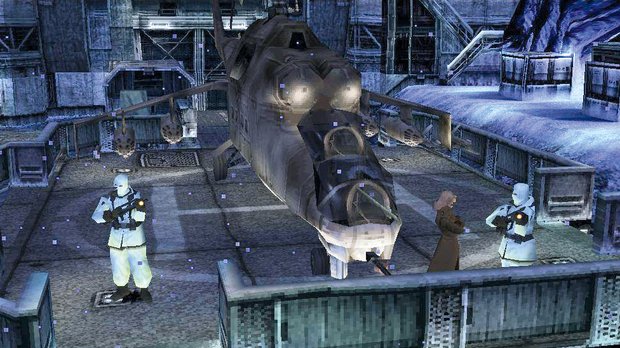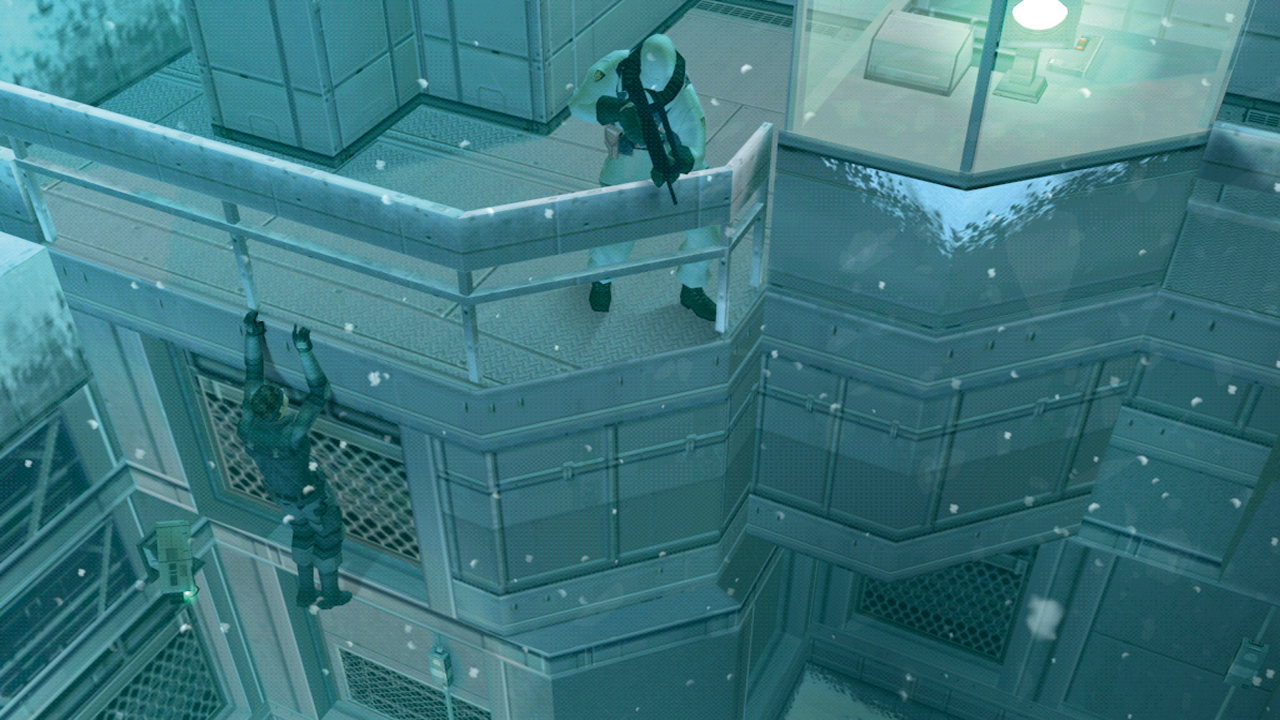How Shadow Moses sets the tone for all things Metal Gear Solid
Cold war. It’s Metal Gear Solid’s theme. Missile silos, nuclear warheads and statesman-like fingers hovering over red launch buttons while trust between nations ebbs toward disintegration. It’s a game about 20th-century dread, the fear of annihilation in an apocalyptic blast; about the notions of your enemies lying hidden under your beds.
It’s also Metal Gear Solid’s modus operandi. Shadow Moses is a remote Alaskan island so icy that the soldiers stationed there must be injected with peptides to prevent their blood from freezing beneath their white furs. It’s home to Alaskan field mice, wolves, ravens, pine trees and little else, flora and fauna grown hardy in the snowy blast of its winds, an ecosystem forced into efficiency as warmth and energy became a premium.

You arrive in this place via icy waters, propelled through a cave to emerge, dripping, on a cargo dock. But it’s not until Solid Snake takes the elevator to the helipad (the island is too small for a runway) that it begins to make sense why such a remote locale should provide the ideal focal point for a game based on such broad themes. Bleak, hostile, a swarm of snowflakes in the night reducing visibility, it is just about the perfect place to hide a top-secret nuclear-launching robot from the eyes of the world. But then again, it’s just about the perfect place to hide anything.
For all its frozen desolation, the uninhabitable rock which props up this dark tale of military scheming is the perfect companion for Solid Snake. Without its hiding places he could not survive. Often game locations assume the role of a character in games, pressing their personalities on to the story, funnelling the mechanics designers have created to fill them in ways that amplify their effectiveness. But rarely does a location become a true companion to the action, without whom our avatars would simply perish.
You see, for all the radio codec chatter support Snake receives on his one-man infiltration mission – the reassuring advice from Colonel Campbell, the quotations and truisms from Mei Ling, and the Shadow Moses Island tour guide advice from Master Miller – Snake’s main supporter is the island itself. It’s in its nooks and crannies that he finds refuge from the unblinking eyes of CCTV cameras and patrolling grunts. The irony is that, tucked behind some remote rock in the freezing gale, there is far greater security than inside any of the warm buildings farther inland.

The perennial night sky becomes a blanket of safety, the craggy walls friends to be clung to. But Shadow Moses is also an indifferent mistress. Leave a trail of footprints on its white-sheet fields and they’ll lead danger right to you. Crunch its snow underfoot and the sound will alert eager ears, even in the wail of a gale that simultaneously works to muffle them. Shadow Moses is a companion to be used, but never trusted. In this way it fits well with Solid Snake’s circle of friends, whom he always keeps at arm’s length, a habit born of hard lessons learned.
Shadow Moses revels in its contradictions. Most obviously, these are man-made: a nuclear-weapons disposal facility that secretly doubles as a weapon development complex. But they are also natural. Formed by the eruption of a volcano on one of the Fox Islands at the eastern end of the Aleutian chain, here is a frozen expanse born of molten heat. And while its extremities may be cold and bitter, the foundry and blast furnace (established to make building materials used to construct the base) ensure it has a warm heart, one visited more than once over the course of the game.
Sign up to the GamesRadar+ Newsletter
Weekly digests, tales from the communities you love, and more

Indeed, as you inch towards the endgame face-off in the launch-room heart of the base, the literal temperature rises along with that of the plot. You feel your way from the cold exterior towards the white-hot core of both the story and island itself. But it’s not a journey played out on a linear temperature scale. With key locations (and the core members of Fox Hound who form the boss battle punctuation marks to the game flow) on the island dispersed across separate buildings, Snake must always head back out into the frozen air as he works his way from interlocking hotspot to hotspot.
The walkways connecting the points of drama take various forms. One canyon is home to an M1A1 Abrams tank, whose bulk fills the passage the same way as the cackling laughter of its driver, Vulcan Raven. Another is a literal walkway, linking two communications towers, 28 storeys up over a glacier that’s blocking the overland route. Then, of course, there is the snow field, a barren expanse of pure white upon whose innocence Sniper Wolf’s blood is spilled as she pleads to be set free. The island’s indifference to poetic death speeches is made clear by a top-down camera that watches as snow covers both her body and her memory, even as her final breath is drawn.
In the end, you leave the way you arrived, through a supply-route tunnel that leads out of the complex, and complexities, through which you burrowed. Shadow Moses Island stands, resolute, watching your departure as it awaits its own fate: an aerial nuclear strike arranged to keep the incident out of the public eye.

Looking back, it’s hard not to feel as conflicted about the place as it appears to be about itself. Shadow Moses is a beautiful protector, under whose wing Snake crawls and finds continual salvation. But it is as cold-hearted as it is clothed, a combination that creates the sort of emotional place from which it is always toughest to move on.
Read more from Edge here. Or take advantage of our subscription offers for print and digital editions.
Edge magazine was launched in 1993 with a mission to dig deep into the inner workings of the international videogame industry, quickly building a reputation for next-level analysis, features, interviews and reviews that holds fast nearly 30 years on.



